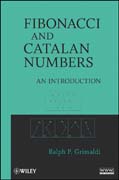
In this one-of-a-kind book, Ralph Grimaldi uses his extensive experience fromthe classroom and as a leader of mini-courses to present an accessible, single resource on the topics of Fibonacci Numbers and Catalan Numbers. The book first embarks on a complete treatment of Fibonacci numbers. Starting with a historical background on the topic, the author goes on to present the properties of Fibonacci numbers, a slew of introductory-level examples, and in-depth discussion of related topics including compositions and palindromes; tiling and Fibonacci numbers; solving linear recurrence relations; graph theory; Lucas numbers; and alternate Fibonacci numbers. The second half of the book explores Catalan numbers, and the author builds a complete foundation to the topic using a historical background and introductory examples, along with coverage of partial orders, total orders, topological sorting, graph theory, rooted ordered binary trees, pattern avoidance, and the Narayana numbers. Coverage of both topicsare accompanied by interesting, real-world examples from areas such as sports, botany, and computer science. Each section concludes with detailed exercise sets that can also serve as extended examples of the presented material along with selected solutions. An Instructor's Manual featuring complete solutions is available upon written request, and extensive reference sections outline resources for further study of the discussed topics. INDICE: Preface xi Part One. The Fibonacci Numbers 1. Historical Background 3 2. The Problem of the Rabbits 5 3. The Recursive Definition 7 4. Properties of the Fibonacci Numbers 8 5. Some Introductory Examples 13 6. Composition and Palindromes 23 7. Tilings: Divisibility Properties of the Fibonacci Numbers33 8. Chess Pieces on Chessboards 40 9. Optics, Botany, and the Fibonacci Numbers 46 10. Solving Linear Recurrence Relations: The Binet Form for Fn 51 11. More on +/- and 2: Applications in Trigonometry, Physics, Continued Fractions,Probability, the Associative Law, and Computer Science 65 12. Examples from Graph Theory: An Introduction to the Lucas Numbers 79 13. The Lucas Numbers: Further Properties and Examples 100 14. Matrices, The Inverse Tangent Function, and an Infinite Sum 113 15. The ged Property for the Fibonacci Numbers 121 16.Alternate Fibonacci Numbers 126 17. One Final Example? 140 Part Two. The Catalan Numbers 18. Historical Background 147 19. A First Example: A Formula for the Catalan Numbers 150 20. Some Further Initial Examples 159 21. Dyck Paths, Peaks, and Valleys 169 22. Young Tableaux, Compositions, and Vertices and Ares 183 23. Triangulating the Interior of a Convex Polygon 192 24. Some Examples from Graph Theory 195 25. Partial Orders, Total Orders, and Topological Sorting205 26. Sequences and a Generating Tree 211 27. Maximal Cliques, a Computer Science Example, and the Tennis Ball Problem 219 28. The Catalan Numbers at Sporting Events 226 29. A Recurrence Relation for the Catalan Numbers 231 30. Triangulating the Interior of a Convex Polygon for the Second Time 236 31. RootedOrdered Binary Trees, Pattern Avoidance, and Data Structures 238 32. Staircases, Arrangements of Coins, Handshaking Problem, and Noncrossing Partitions 25033. The Narayana Numbers 268 34. Related Number Sequences: The Motzkin Numbers, The Fine Numbers, and The Schröder Numbers 282 35. Generalized Catalan Numbers 290 36. One Final Example? 296 Solutions for the Odd-Numbered Exercises 301 Index 355
- ISBN: 978-0-470-63157-7
- Editorial: John Wiley & Sons
- Encuadernacion: Cartoné
- Páginas: 384
- Fecha Publicación: 24/02/2012
- Nº Volúmenes: 1
- Idioma: Inglés
